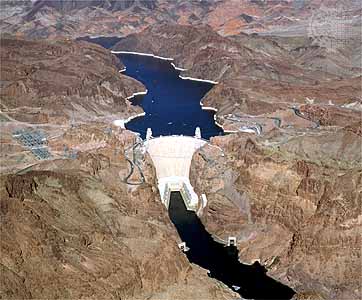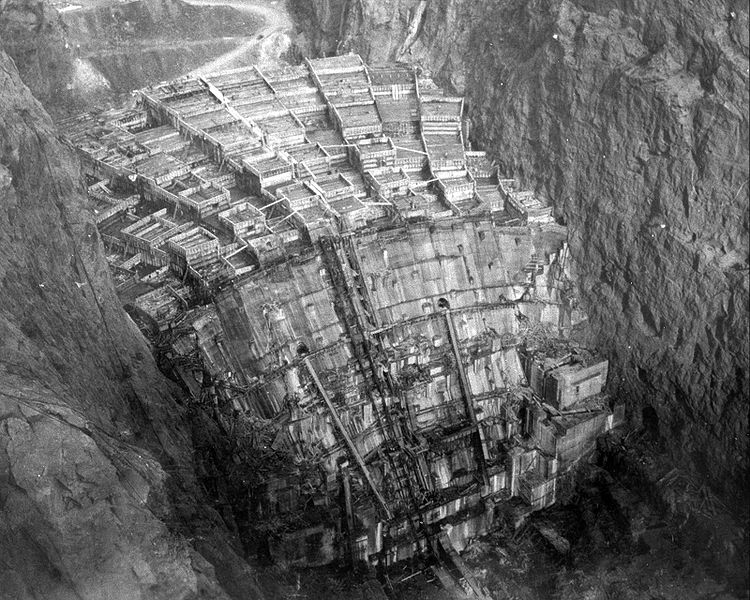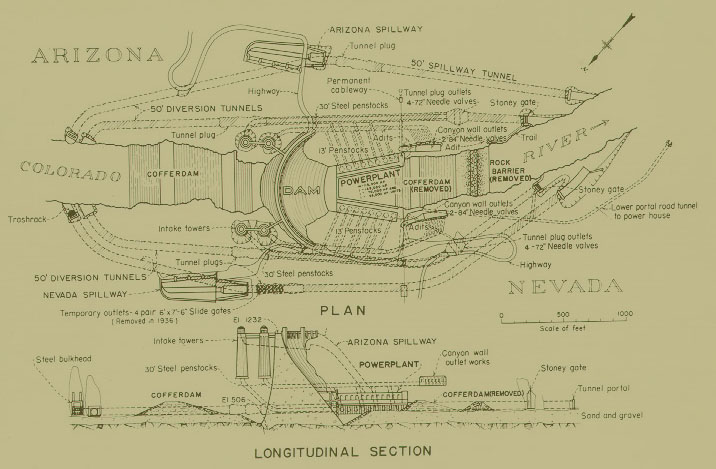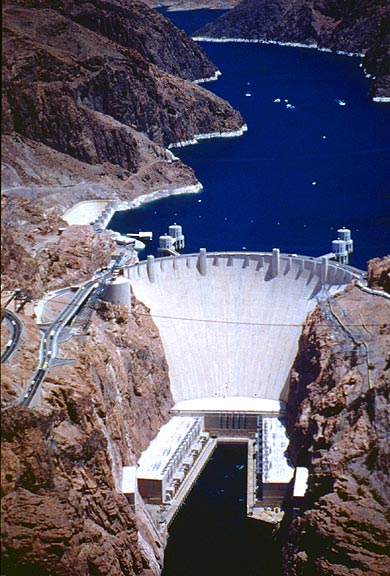Hoover dam is built in the Black Canyon of the Colorado River in the United States and is located on the border between Arizona and Nevada. Construction of the dam, which began in 1931 and completed in 1936, was a result of great effort that was made possible by thousands of workers, some of whom died during the construction process (Burns 1). These workers were united under a conglomerate known as Six Companies, a group of six construction companies formed to build Hoover Dam. The number of contracted workers reached 5,251 by July 1934, most of who had come from other states, the total number of employees during the construction was 21,000 men.
The main purpose of the dam’s construction was to control periodic floods, provide a regular water supply for states around this area, namely Nevada, California and Arizona, generate hydroelectric power and improve transport activities on the Colorado River. The dam is a source of water for irrigation and its construction led to the formation of Lake Mead, a 233 sq. foot water body that is used for leisurely activities such as fishing and sailing (Cohn). Hoover Dam has a height of 726.4 feet (221 m), is 660 feet (201m) wide and has a total volume of 3,250,000cubic yards (2,480,000 m3). The hydro-electric power plant was constructed at its base and consists of 17 turbines, nine of which are in the Arizona while eight are in Nevada. These turbines produce 4.2 billion Kilowatt-hours on average.

Construction of the dam began with the diversion of the Colorado River to give space, as the dam was to lie on its path. This was done by digging four diversion tunnels through the Black Canyon, these were roughly 56 feet in diameter and approximately 4,400 feet long and were constructed during the late fall and winter when the water levels were low and diversion was easier. Two tunnels were dug on the Nevada side and the other two on the Arizona side of the canyon, explosives were used to create these tunnels, and a ton was used for every 14 inch of tunnel made (Duchemin 4). They were then lined with concrete, starting with the base; this was done by the use of gantry cranes moving on rails. Next were the walls and workers used movable steel structures for this purpose, finally, the roof were lined using pneumatic guns. After lining, the tunnel diameters reduced to 50 feet (15 m). The Colorado River was then diverted to the Arizona tunnels while those in the Nevada side were left to be used during the fall.
To protect the workers at the site from the Colorado River, two cofferdams were constructed to protect against the likelihood of the river flooding, they were 96 ft (29 m) high and 750 feet (230 m) thick, it was thicker than the dam. Once these were built and the river diverted, the work of digging out the foundation for the dam began, first, the erosion soils that had built up were removed until the bedrock was reached and since the dam was an arch-gravity kind, the side walls were dug out too as the canyon would support the dam’s weight. Loose rock on the wall of the canyon were removed by ‘high scalers’ as these posed a danger to the workers; high scalers were suspended using ropes (Dunar 5).
Concrete was poured into the dam in the early June of 1933 and since concrete heats and contracts as it dries, the possibility of uneven cooling posed a challenge to the workers. Government engineers determined that the concrete was poured in a single continuous process, it would take 125 years for the concrete to cool and this would lead to weaknesses that would lead to weaknesses on the wall and subsequently crack (True 2). To solve this, the excavated area was marked with rectangles and concrete blocks poured into the area. 1-inch steel pipes were inserted into the blocks and were used to pass river water and ice, once the blocks had cooled, the workers filled the pipes with grout, the spaces between the blocks were also filled up using grout and this enhanced the strength of the structure (Hiltzik 5).

Concrete was carried to the site in large steel buckets with a height of 7 feet (2.1 m) and almost the same diameter; they were filled at huge concrete plants located on the Nevada side of the canyon. They were transported to the site by specially made rail cars suspended on aerial cables; these buckets were moved to the right columns (block) and opened up from the bottom, workers the evened out this concrete. These buckets had to be moved to the right blocks, as each block required a specific grade of concrete, from grain-sized gravel to large stones 9inches in diameter. More than 3,250,000 cubic yards (2,480,000 cubic meters) of concrete was used in construction and a total of 1,110,000 cubic yards (850,000 cubic meters) used at the power plant and other construction sites (Marsh 12). The pouring of concrete was completed in May 1935; two years after the diversion pipes had been built.
Cofferdams had been constructed over tunnels 2 and 3 and when winter set in, they were built over tunnel 4 while tunnel 1 was fitted with valves to control water flow. On February 1935, a 1,000 ton steel structure was lowered over tunnel 4, the cofferdams were the taken away making it possible to control the Colorado River. Water began to flow into Hoover Dam and this marked the end of its construction (United States Energy Information Administration 1). The summary of the construction plan is shown in the diagram below (Rodriguez 12).

Spillways
Two spillways were constructed behind each of Hoover Dam’s abutments and run almost parallel to the walls of the canyon, each spillway is fitted with gates that can be raised or lowered depending on the water levels in the dam and flood conditions. Water flows over the spillways and drops 600 feet into 50 feet wide tunnels, it then flows to the outer diversion channels and rejoins the river.

Completion of the dam construction has led to some negative environmental impacts, ten years after its construction; more than 600 earthquakes have been reported with magnitudes ranging from 2 to 5. The earthquakes were common during the early years due to the high level of water; the instances of seismic activities have however fallen due to a drop in water volumes over the years (Stevens 10).
Work Cited
Burns, William. The worlds Water, 2002-2003: The Biennial Report on Fresh Water Resources. Washington DC: Island Press. 2001. Print.
Cohn, Jeffrey. “Resurrecting the dammed: A look at Colorado River restoration”. BioScience 51.12 (2001): 998–1003.
Duchemin, Michael. “Water, power, and tourism: Hoover Dam and the making of the New West”. California History 86.4(2009): 60–78.
Dunar, Andrew; McBride, Dennis (1993). Building Hoover Dam. Reno, Nevada: University of Nevada Press. 1993. Print.
Hiltzik, Michael. Colossus: Hoover Dam and the Making of the American Century. Norman, Oklahoma: University of Oklahoma Press. 2010. Print.
Marsh, Paul, Deacon, James, Dowling, Thomas, Hedrick, Philip, Matthews, William, Mueller, and Gordon. “A conservation plan for native fishes of the lower Colorado River”. BioScience 53.3 (2003): 219–234.
Rodriguez, Carlie, Flessa, Karl, Téllez-Duarte, Miguel, Dettman, David, Avila-Serrano, Guillermo. (2001). “Macrofaunal and Isotopic estimates of the former extent of the Colorado River Estuary, Upper Gulf of California, Mexico”.. Journal of Arid Environments 49 (2001): 183–193.
Stevens, Joseph. Hoover Dam: An American Adventure. New York City: Free Press. 1988. Print.
True, Jere, Kirby, and Victoria Tupper. Allen Tupper True: An American Artist. San Francisco: Canyon Leap. 2009. Print.
United States Energy Information Administration. A Report from Energy Ant — My Trip to the Hoover Dam near Boulder City, Nevada. Hoover Dam Hydroelectric Plant.